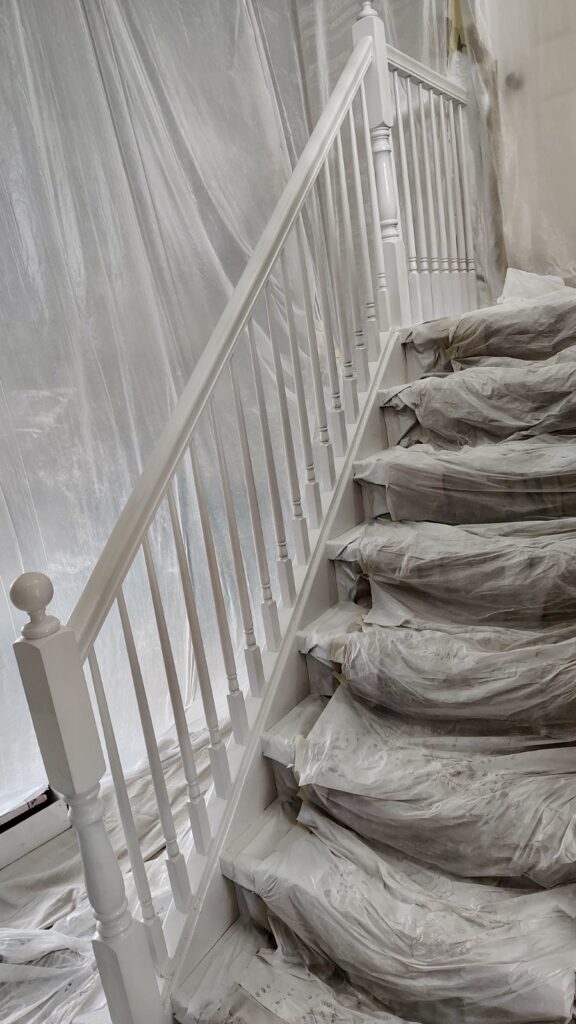
Recently, we were privileged to work on stairway railing and banister area projects for two different homes. Here, we take a closer look at the differences, similarities, and challenges of these two interior painting projects. Although there were similarities between the two projects, they each came with unique challenges that resulted in varied time frames and costs.
Learn the different factors that affect the timeline and price of interior residential painting when we provide an estimate.
The Challenges Involved with Interior Painting
Before we could do an amazing job on interior stairway railings and banisters in these homes we needed to map out the challenges involved fully. Each of these interior painting projects had homeowners who worked remotely in their house, and each had kids and dogs living in the house. We set up an isolated working area to keep everyone safe, stay out of sight of virtual calls, and prevent paint on dog paws. We dropped plastic around the area that our team was working within. We also strived to get as much done in as little time as possible. We used as many team members as we could without encumbering the workspace.
Both homes had high ceilings of 18 feet or more. We maneuvered the plastic across the ceiling to mitigate and control the dust and small organic compounds. This kept everything neatly in the work area and unable to spread throughout the house. While you can’t always see the dust and organic compounds created during a painting project, they are there. This is especially true when painting the interior of a house because there is nowhere for these small particles to escape.
Another challenge we face when painting the spindles of a stair banister is getting into all the angles and details of the spindles. While some spindles are simple, others have many details within each spindle. The paint brush needs to get into all of the tiny crevices and nooks of the spindle design without interfering with the adjacent spindles that have already been painted and still have wet paint.
The Different Processes for Residential Painting
Although both of these interior painting projects involved painting the railings and banisters similarly, each involved a different process.
The complexities of stairway rail painting
Both of the homes for these projects had wooden railings, and the homeowners wanted paint instead of stain. We used a high-quality paint that will withstand the wear and tear of kids, animals, and life in general. Natural wood needs to be primed before painting. Primer provides a much more adhesive surface than painting directly onto the wood.
The railings in these homes were very similar in size, but the different factors made one project more time-consuming, which in turn comes at a higher cost. The details in a banister and railing project are very important. It’s a part of your home that you touch often and is very visible. This means you want an extremely smooth finish and eye-catching railing and banister. Both of these projects required time and detailed work to have the end result of a stellar finish. We used an airless sprayer to ensure a smooth and flawless finish. Using a brush and roller runs the risk of leaving brush marks and stippling caused by the roller nap and paint pulling on the nap as it is applied.

Two paint colors and worn wood equal more prep time
One way to get creative with the paint and style in your home is to have a two-tone stair railing. Homeowners should be aware, however, that two different colors of paint require more labor time and materials to prepare and dry before painting the second color. One of our stairway projects also needed to have the trim and risers painted. The trim and risers are at the base of the stairs going up the sides. These require much more prep work before painting.
Another factor that can add more labor is the condition of the wood and railing area. In one of the homes, we had to replace a few spindles and spent lots of time spackling, caulking, and sanding down areas of the railing. This was necessary to achieve a beautiful and smooth finish.
Pricing Interior Painting for Stairways
There can be many factors that influence the price of interior stairway railing painting. Even though our two painting projects involved the same area of the home, they had some big differences that affected the project’s cost. The stairway that required only minor prep work and a single color was completed in one day. The other two-tone stairway, which also needed wood repair and prep work, took two and a half days. Your stairway painting quote will depend on all of these factors. You can expect to pay between $1,500 and $3,500 to get a beautiful, smooth, professional finish using high-end painting products on your interior painting project.
